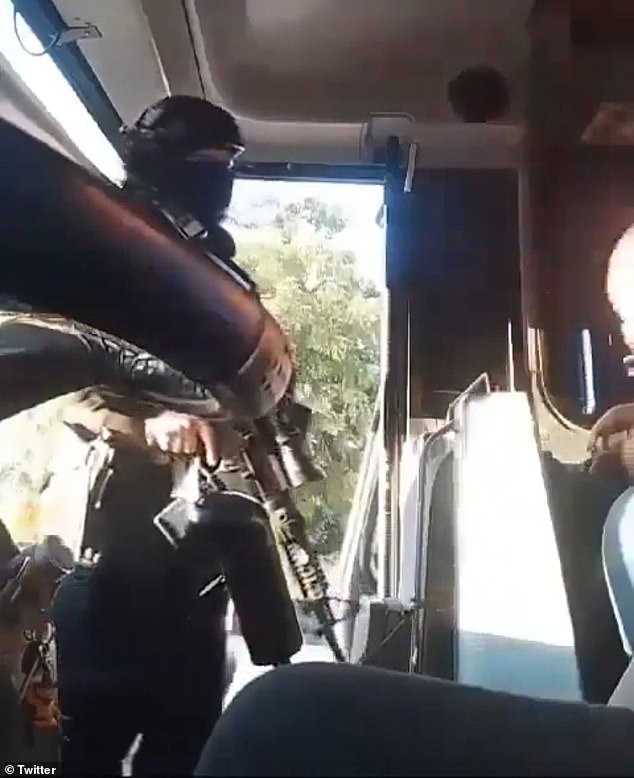
France‘s Minister of Justice courted controversy last month when he declared that no corner of the country was safe from the scourge of drug dealing.
Speaking to French podcast LEGEND, Gérald Darmanin said even the ‘smallest rural town’ in France is now blighted by the illicit drugs trade.
‘Drugs have always existed, but today we can clearly see that in the smallest rural town, they know about cocaine, cannabis.
‘Beforehand, drugs were simply in big towns [and cities] or the metro… it has become widespread, metastasised,’ he added.
Many dismissed the statement, in which he went on to rail against escalating violence and call for law enforcement crackdowns, as little more than political rhetoric laying the groundwork for a widely anticipated presidential campaign ahead of 2027.
Two weeks later, authorities announced the bustof a luxury villa-turned methamphetamine manufacturing facility in the sleepy countryside commune of Le Val in southeastern France.
Suddenly, Darmanin’s warning didn’t seem so alarmist.
The secret lab was later found to be the first confirmed operation of Mexico’s infamous Sinaloa cartel on French soil, raising fears that one of the world’s biggest and most dangerous criminal organisations is looking to expand its operations into Europe.
Police claimed the lab was set up by a group of Mexicans in 2023 who arrived in France and began renting the villa. It transpired they had been commissioned by the cartel to build a meth production facility, recruit and train people in France to run it, before moving elsewhere.
That terrifying discovery came less than three months after Spanish police arrested 27 members of MS-13 – the Los Angeles-based gang formed by immigrants from El Salvador – that US President Donald Trump has designated a terrorist organisation.

A member of a Sinaloa Cartel faction was seen boarding a bus and advising the driver and passengers to reconsider travel to Culiacán, the capital of the northwestern Mexican state of Sinaloa, where cartel infighting left at least two cartel members and a soldier dead

Crime scene investigators work at the site where a body was found lying on a street in La Costerita neighborhood of Culiacan, Sinaloa, amid escalating cartel violence

Prisoners with MS-13 gang tattoos looks out of his cell as Department of Homeland Security Secretary Kristi Noem tours the Terrorist Confinement Center (CECOT) on March 26, 2025 in Tecoluca, El Salvador
MS-13 representatives were reportedly seeking to rapidly expand their operations in Spain and had planned to carry out a contract killing.
The shocking busts validate a 2022 report in which Europol claimed that its intelligence suggested Mexican cartels were dramatically scaling up their operations in Europe amid an increase in seizures of cocaine and methamphetamines.
Europe’s illicit drug market is now booming, worth at least €31 billion (£26 billion) according to a 2024 report by theEuropean UnionDrugs Agency (EUDA).
Cocaine is the second most commonly used illicit drug in the EU behind cannabis and the second largest illicit drug market by revenue generated, accounting for roughly one third of revenues.
Organisation for Economic Co-operation and Development (OECD) figures suggest that the UK & Ireland, the Netherlands and Spain rank in the top five countries across Europe where cocaine use is most prevalent, with France, Italy and Spain also topping the charts for cannabis consumption.
The majority of narcotics bought and sold in Europe, particularly cocaine, originates from Latin America, primarily Colombia, Peru, Ecuador and Bolivia.
Cartels in these countries, as well as the likes of Brazil’s PCC criminal organisationleverage their formidable network of contacts with criminal enterprises and crime families across Africa and Europe to ensure their product makes it to consumers in the UK and on the continent.
Some of the most notorious European groups involved in the trafficking include Italy’s ‘Ndragheta and Camorra crime families, Grupa Amerika and the Tito and Dino cartel in the Balkans, and the Kinahan Clan and ‘The Family‘ in Ireland, andthe Dutch-Moroccan ‘Mocro Maffia’.

A fire burns as prison staff block the entrance after gunmen freed a drug dealer, killing two prison guards and severely wounding three others, in Val De Reuil, France, May 15, 2024

Rotterdam Public Prosecution Service shows 17,637 pounds of cocaine in Rotterdam, The Netherlands after it was seized by customs authorities. Rotterdam is one of three major European ports where cocaine floods through in to Europe

An MS-13 gang member is seen in a cell at a detention center

A drugs menu pictured sprayed onto a wall in Nimes – where a 10-year-old boy was killed in suspected drugs violence in 2023
Despite Mexico’s reputation as a hub for some of the world’s most feared and well-established drug trafficking operations, cartels here have traditionally favoured the US market over Europe.
Their proximity and penetration into the American market meant Mexican cartels have long ‘taken charge of the buying, trafficking and sale (of cocaine and other narcotics) in the United States’, according to Rafael Guarin, a former presidential security adviser in Colombia.
But the return of Donald Trump to the White House has seen a raft of measures designed to target cartel activity and limit the flow of fentanyl, among other drugs, across the border.
Trump has pressured Mexican President Claudia Sheinbaum into getting serious on tackling the cartel’s outsized influence in her nation, offering to lend US military aid and increase intelligence sharing between Mexican authorities and American security services.
This, coupled with the higher street value of cocaine and other drugs in Europe versus North America, may be forcing the likes of the Sinaloa cartel, MS-13 and their rivals to make efforts to diversify.

A Colombian Police boat is seen next to a submarine that was found to be transporting 2.5 tonnes of cocaine. Two bodies of drug traffickers were found onboard

An undated handout photo made available by Spain’s Civil Guard that shows the arrest of people orchestrating a network of drug dealing between South America and Europe

Speaking to French podcast LEGEND in May, Interior Minister Gérald Darmanin said even the ‘smallest rural town’ in France is now blighted by the illicit drugs trade

Investigators inspect packages in a container in the port of Antwerp

Federal agents seize submarine off Puerto Rico’s Caribbean Sea coast carrying a record 2,500 kilos of cocaine
Your browser does not support iframes.
Though the Sinaloa cartel will face the challenge of establishing its own criminal network in Europe if it hopes to muscle in on the continental market, the methods of transporting huge quantities of drugs across the Atlantic are already tried and tested.
Hundreds of tonnes of narcotics enter Europe every year via gigantic shipping containers.
Corrupt officials and cartel plants in place at both departure and receiving ports hide the drugs inside the containers and retrieve them at the other end.
In the departure port, dock workers identify a container going to a port of interest, break into it, and stash the drugs among legitimate goods before sending its ID number to workers at the other end.
At the receiving port, dockers make sure the dirty container is put in a specific spot where it is easy to access so it can be opened once again, the drugs removed and smuggled out of the port, and any security tags replaced with forgeries before it passes customs.
Where smugglers cannot persuade the dockers to aid them, they sometimes send an empty container into the port with some of their men inside, who then break out and retrieve the stash in a method known as Trojan Horse.
The Netherlands and Belgium have long served as the primary entry points for drug traffickers shuttling cocaine into Europe, particularly via port cities like Rotterdam and Antwerp.
The latter last year topped the list of European cities where cocaine consumption is at its most voracious, with a March 2024 report by EUDA and SCORE group – a Europe-wide sewage analysis network – finding that1,721 milligrams of cocaine were detected per 1,000 people per day in the port city.
The Spanish region of Galicia is also renowned as one of the key gateways for drugs into Europe. Its ports were among the first to receive regular shipments from South American cartels as early as the 1970s and 1980s.

Spanish police show a raid on a cartel submarine

Drug traffickers are arrested after being hauled off a submarine carrying huge quantities of drugs

Crewmembers of a suspected drug trafficking submarine are seen following their arrest in waters off Portugal
More recently, cartels and criminal organisations have turned to yet more complex methods to ensure their product makes it into the hands of gleeful Europeans.
To avoid seizures at ports, cargo ships are sometimes approached atsea by cartel fast boats. Either with money or force, the crew are persuaded to take the drugs on board before continuing their journey across the ocean.
Before they reach land on the other end, more fast boats are dispatched to retrieve the drugs, meaning the cargo ship enters port as clean as when it departed.
The cartels are so well funded that some have their own submarinesdesigned to carry the maximum amount of weight possible while being operated by a crew of just three.
Authorities estimate that each vessel costs around $1million (£750,000) to make and are painted sea blue, meaning they can leak just beneath the waves and surface under cover of night for their crew to emerge.
‘Narco submarines are being built in rivers and mangroves. That’s why, for example, the Amazon river in Brazilis perfect. As soon as you open Google Maps, you realise it’s a labyrinth of islets and mangroves and tributaries’, Javier Romero, a local journalist, told the Wall Street Journal.
‘You can hide a shipyard, then you can build it, put it into the water, and with the cover of darkness you launch it into the night.’
Once the product arrives on the eastern side of the Atlantic, drug cartels and their European associates take advantage of vulnerable child migrants, using them as foot soldiers and mules to distribute their haul.
Younger migrants, particularly those unaccompanied by older family members, are seen as ideal targets for recruitment.
These children and young adults are typically in a precarious position – often with no means to support themselves and no legal status – and are therefore desperate for cash while their anonymity and perceived innocence make them less susceptible to detection by law enforcement.
North African children, particularly Moroccans and Algerians, are thought to be those most at risk, with a recent EU police force investigation cited by the Guardiandeclaring: ‘Sweden, Belgium, the Netherlands, Spain and France presented several concrete cases of the exploitation of hundreds of north African minors, recruited by drug trafficking networks to sell narcotics.’
European police sources said the use of child drug mules was being conducted ‘on an industrial scale’.



